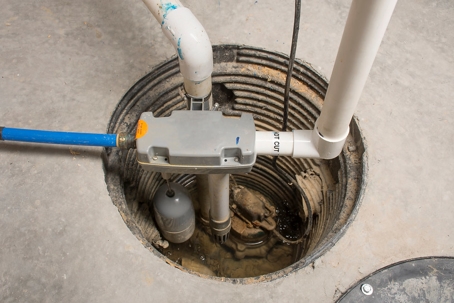Understanding How Your Sump Pump Works & How To Maintain It
What Is a Sump Pump Used For?
A sump pump is a device that helps prevent flooding in your basement by activating when water levels rise. When water gets into your basement’s foundation, whether from a spring snowmelt or heavy rainfall, gravity will cause it to flow to the lowest point. This low point in the basement’s foundation is where you will typically install a sump pit and pump.
Here’s how it works:
- The sump pit is positioned at the foundation’s low point and will collect water.
- Once the water rises to a certain height it will activate the pump, removing the water through a discharge pipe that leads outdoors.
- The pump will stay active until the water is under a certain threshold, ideally saving your house from extensive water damage.
Keep your head above water! Here are some ways to maintain your sump pump and maximize its life:
- Know when to replace it. Contact R&D Plumbing and Heating to book an inspection.
- Sump pumps have a life expectancy of approximately 10 years. Track the age of your pump and replace it every 10 years or sooner.
- Conduct seasonal check-ins. Seasonal check-ins will help ensure your pump is ready to discharge unwanted water. Checking your sump pump is especially important in the spring to make sure it discharges water from the winter and makes room for spring rainfalls.
- Do a visual assessment. Make sure water has not overflowed from the pit onto the basement floor. Inspect the power cord to ensure it is securely inserted into the electrical outlet and is in good visual condition. Never use an extension cord or power bar—these electrical resources are not designed to function in wet or damp conditions.
- Test the pump. Pour water into the pit until the pump is activated and see how well it’s discharging the water. If the pump doesn’t activate, you may have a faulty switch. If it does activate, it should lower the water level in the pit and remove almost all the water. Your sump pump check valve is what prevents water from filling the pit after it’s been flushed away.
- Check your discharge line. Go outside and ensure your discharge line leads away from your home and water is flowing out of the pipe. Address any blockages caused by grime and sediment build-up. Your discharge line should be checked frequently during freeze and thaw periods such as spring and fall.
- Alarm your pump. An alarm will sound in the event of a higher than usual water level within the pit. This will alert you to take action to prevent basement flooding. You can also connect the alarm to a monitored security system so everything is streamlined.
- Consider purchasing a backup generator. One of the main causes of sump pump failure is a power outage. To prevent an outage from affecting your pump, you could purchase a backup generator that can be manually activated.
- Make sure your pump is properly installed. It may sound obvious, but having an R&D professional install your sump pump properly can prevent many issues throughout its lifecycle.
Regularly cleaning your sump pump will help it function at its best. We recommend cleaning your sump pump at least once a year but always check your manual for more information. Before you clean your pump, here’s what you’ll need:
- Tarp or plastic sheet
- Tool(s) for removing debris
- Large bucket
- Hose
- Wet/dry vacuum for cleanup
- We also recommend cleaning your pump when it’s not raining and no appliances are draining into the sump pump basin.
In seven steps, here’s how you can clean your sump pump:
- Disconnect the pump from the power supply. This step is extremely important in order to protect yourself from electric shock. Make sure you unplug the sump pump or turn off the breaker at the power source before you start cleaning.
- Wrap the pump in a sheet. To reduce the mess, wrap the bottom of the pump in a plastic tarp or sheet. Give yourself enough space to move around the pump as you clean.
- Clean the debris. We recommend hosing down the pump to remove loose residue. If there is any debris stuck to the pump, use your tools to pry it loose.
- Rinse the pump. Spray the pump again with your hose to remove any remaining debris.
- Drain the check valve. The check valve is located at the top of your sump pump and it is used to prevent water from flowing back into the pump. Drain the valve and catch any remaining water in your bucket, then discard the water.
- Use your wet vacuum to remove standing water from the sump pit. Remove any water that’s in the bottom of the pit and clean any water that got on the tarp while you cleaned.
- Reconnect the pump. Reconnect your pump to the power source and turn your breaker back on if you turned it off. Ensure everything is connected and all parts are returned to the sump pump.
Having a sump pump in working order is an easy way to prevent water damage in your home. If you are unsure if your sump pump is working correctly, reach out to R&D Plumbing and Heating for the best protection possible.

